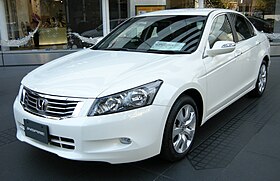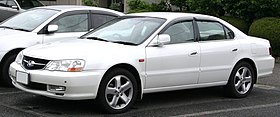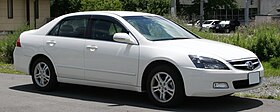Honda Inspire
This article needs additional citations for verification. (November 2015) |
| Honda Inspire | |
|---|---|
 | |
| Overview | |
| Manufacturer | Honda |
| Also called | Honda Vigor (1989–1995) Honda Saber (1995–2003) Acura TL (1995–2002) Honda Accord (2003–2012, 2018–) |
| Production |
|
| Assembly | Sayama Plant, Sayama, Saitama, Japan (1989-2012) Marysville, Ohio, USA (Marysville Auto Plant) (1995-2012) |
| Body and chassis | |
| Class | Mid-size |
| Body style | 4-door sedan |
The Honda Inspire is a mid-size sedan introduced by Honda in 1990 derived from Honda Accord chassis. The first Inspire debuted in 1990 as the Accord Inspire, a sister nameplate to the Honda Vigor, but sold at different retail channels in Japan, known as Honda Verno for the Vigor/Saber, and the Inspire at Honda Clio stores. The Inspire was developed during what was known in Japan as the Japanese asset price bubble or "bubble economy".
In 1995 the Inspire was updated by the second generation model, on a platform it shared with the Honda Legend, and exported to the US as the Acura 3.2 TL, while the Vigor nameplate was replaced with the Honda Saber. The longitudinal 2.5 L straight-5 engine layout and platform remained and was sold as the Acura 2.5 TL.
In 1999 these cars were replaced by the third generation TL that was based on the US-spec Accord platform, and largely designed and engineered in the US by Honda R&D Americas, Inc. in Raymond, Ohio. Manufactured in the US, these were imported into Japan as the new Inspire and Saber.
In June 2003, the fourth generation Inspire was introduced in Japan derived from the North American Honda Accord V6. This Inspire marks the first time Honda introduced their Variable Cylinder Management technology. In October 2005, the fourth generation Inspire received a mild restyle, with new headlights, new taillights, revised interior and new colors. The Inspire targeted the Nissan Teana, the Toyota Mark X and numerous other entry level luxury cars from Japan.
In October 2007, the fifth generation of the Inspire was previewed at the Tokyo Auto Show. It is essentially a rebadged 2008 North American-market Accord with minor exterior and interior modifications.
In September 2012, after 6 generations and the introduction of the ninth generation Accord, the Inspire ended production for a short period after 23 years before relaunching in 2018 as a China-only model based on the tenth generation Accord.
First generation series CB5, CC2 & CC3 (1989–1995)
| First generation | |
|---|---|
 | |
| Overview | |
| Also called | Honda Vigor Acura Vigor |
| Production | 1989–1995 |
| Body and chassis | |
| Body style | 4-door sedan |
| Layout | Longitudinal front-engine, front-wheel drive |
| Powertrain | |
| Engine | 2.5 L G25A1 Straight-5 2.0 L G20A1 Straight-5 |
| Transmission | 4-speed automatic 5-speed manual |
| Dimensions | |
| Wheelbase | 2,805 mm (110 in) |
| Length | 4,690 mm (185 in) (G20 engine) 4,830 mm (190 in) (G25 engine) |
| Width | 1,695 mm (67 in) (G20 engine) 1,775 mm (70 in) (G25 engine) |
| Height | 1,355 mm (53 in) (G20 engine) 1,375 mm (54 in) (G25 engine) |
| Curb weight | 1,270 kg (2,800 lb) (G20 engine) 1,440 kg (3,170 lb) (G25 engine) |

On October 12, 1989, the Honda Accord Inspire was introduced. The platform was shared with the Honda Vigor, a JDM Honda Accord derived five-cylinder luxury sedan available only at Honda Verno dealerships. The Inspire was introduced before the recession developed in Japan in the early 1990s (known in Japan as the "bubble economy"), and Honda wanted a car that would compete with the Toyota Cresta and Nissan Laurel, with the unique inline 5-cylinder Honda G engine, in a front-wheel-drive configuration. This 5-cylinder engine was also used in the JDM Honda Rafaga, which was a shorter sedan shared with the second generation Honda Ascot. In Japan, the smaller G20A engine used regular grade fuel, while the larger G25A engine used premium grade fuel.
The bodystyle was a 4-door hardtop, but it wasn't a true hardtop, using a "B" pillar between the front and rear passenger compartments, and instead it used frameless doors. The Inspire was available in two versions; a shorter and narrower version badged as the Accord Inspire, with a G20A 2.0L engine in compliance with Japanese vehicle size requirements for cars classified as "compact". The CB5 Inspire was offered in 3 trim levels, the base AZ-I with manual transmission, AG-I with fog lamps and optional sunroof as well as central locking, and the top spec luxury AX-I with leather upholstery, more safety features and full cruise control as well as power seats. A longer and wider version with the 5 cylinder G25A 2.5L engine debuted in early 1992, similar in dimensions to the first generation Legend. The larger CC2-CC3 Inspire was a mild refresh of the first CB5 Inspire, featuring updated full-width boot lamps (the updated Vigor had conventional single lamp units) with less chrome, larger bumpers with new wrap-around cornering lamp design (instead of the optional separate units like the CB5) and mesh alloy wheels. Following the 1992 refresh, the Inspire offered fewer trim levels and the inline-5 received upgrades (power was up from 118KW to 140KW). The CC2 Inspire shared more features with the Acura Vigor under a 'wide-body' marketing campaign with minor differences.
The Inspire offered a luxurious approach to the interior as a lower price alternative to the top level Legend, and both vehicles were sold at Honda Clio dealerships. Interior appearance was provided by the Japanese furniture company, Tendo Mokko, offering unique leather interior and a choice of genuine wood inserts for the dashboard and center console.
The SOHC 4-valve-per-cylinder G20A Straight-5 cylinder was all new, with a choice of 2.0 L or 2.5 L engine displacement. Japanese buyers had a choice of two engine displacements which was a consideration as to how much annual road tax they were willing to pay. The car with the larger engine had a much higher level of standard and luxury equipment to justify the expense.
The transmission is attached behind the engine, with a driveshaft that sends power to the front of the car to an asymmetrically installed limited-slip differential which then supplies power to the front wheels using half shafts; this allowed the powertrain to remain slightly behind the front wheels. This also gave the car a 60:40 front to rear weight distribution. The turning radius of the Inspire also was not as tight as its competitors due to the use of Constant-velocity joint installed on the front axle half shafts, but the Inspire did have an advantage in adverse traction conditions.
Second generation series UA1 through UA3 (1995–1998)
| Second generation | |
|---|---|
 | |
| Overview | |
| Also called | Acura 3.2 TL Acura 2.5 TL Honda Saber |
| Production | 1995–1998 |
| Body and chassis | |
| Body style | 4-door sedan |
| Layout | Longitudinal front-engine, front-wheel drive |
| Powertrain | |
| Engine | 3.2 L C32A5 V6 2.5 L G25A1 Straight-5 2.0 L G20A1 Straight-5 |
| Transmission | 4-speed automatic |
| Dimensions | |
| Wheelbase | 2,840 mm (111.8 in) |
| Length | 4,840 mm (190.6 in) 4,870 mm (191.7 in) V6 |
| Width | 1,785 mm (70.3 in) 1,800 mm (70.9 in) V6 |
| Height | 1,405 mm (55.3 in) 1,415 mm (55.7 in) V6 |
| Curb weight | 1,360 kg (3,000 lb) 1,430 kg (3,150 lb) V6 |

The second generation Inspire was almost identical in its dimensions to the first generation 1986 Honda Legend, with that vehicle having been updated and enlarged to better fit the role of flagship for the Honda and Acura brands. The second generation Inspire was available with the Type I 3.2 L V6 offered in the Legend on July 6, 1995, while still offering the straight 5 in both 2.0 L and 2.5 L versions. The profile of this vehicle was reduced somewhat to 1,405 mm (55.3 in). The luxury approach was enhanced. A carryover from the previous generation saw marginal increases in length, width, and height dimensions for vehicles installed with the V6 engine, but the smaller dimensions were not in compliance with Japanese government regulations concerning dimensions and maximum engine displacement, thereby giving buyers an incentive in interior accommodations when purchasing the V6 model. Each engine choice obligated the Japanese buyer with increased annual road tax liability, and one trim level package was designated with the engine choice, offering stepped levels of standard and luxury equipment for each selection..
The Inspire, sold at Honda Clio dealerships, was also known as the (Template:Lang-ja) and sold at the Honda Verno sales network, and mechanically identical to the UA1-UA3 Inspire. Starting with this generation, all Inspire and Saber vehicles were manufactured at Honda's Marysville Auto Plant in Ohio, USA.
November 8, 1996 saw the introduction of dual airbags for front seat passengers and anti-lock brakes as standard.
This version of the Inspire competed with the Toyota Camry Gracia, Mark II, Cresta and Chaser, the Nissan Cefiro and Skyline, the Mazda Millenia and the Mitsubishi Diamante.
Third generation series UA4 and UA5 (1998–2003)
| Third generation | |
|---|---|
 | |
| Overview | |
| Also called | Acura TL Honda Saber |
| Production | 1998–2003 |
| Body and chassis | |
| Body style | 4-door sedan |
| Layout | FF layout |
| Related | US-spec Honda Accord |
| Powertrain | |
| Engine | 3.2 L J32A1 VTEC V6 2.5 L J25A VTEC V6 |
| Transmission | 5-speed automatic 4-speed automatic |
| Dimensions | |
| Wheelbase | 2,745 mm (108.1 in) |
| Length | 4,840 mm (190.6 in) |
| Width | 1,785 mm (70.3 in) |
| Height | 1,420 mm (55.9 in) |
| Curb weight | 1,520 kg (3,350 lb) |

The third generation Honda Inspire/Saber was introduced October 15, 1998, and was the first Honda designed and built in the USA and exported to Japan. In North America, this vehicle was sold as the Acura TL, while in Japan it was the second model that accompanied the flagship Honda Legend at Honda Clio Japanese dealerships. The Saber version of this car was sold as the top level sedan at Honda Verno. Honda's internet-based navigation system Internavi was introduced with this generation.
The Inspire no longer offered the Straight-5 engine, and instead offered the 3.2 L J32A V6 and 2.5 L J25A V6 with VTEC, and a choice of a 4- or 5-speed automatic transmission. The bodystyle was changed from hardtop to sedan as a result of the USA-spec Accord having been upgraded to meet USA requirements for improved side impact protection. A cabin air filter, also known as a pollen filter is introduced with this generation and is located behind the glove compartment for all vehicles sold internationally.
The Honda Saber was discontinued April 2003 along with the consolidation of the Honda Japan sales networks Primo, Clio and Verno.
Fourth generation series UC1 (2003–2007)
| Fourth generation | |
|---|---|
 | |
| Overview | |
| Also called | Honda Accord (US-spec) |
| Production | 2003–2007 |
| Body and chassis | |
| Body style | 4-door sedan |
| Layout | FF layout |
| Related | Acura TL |
| Powertrain | |
| Engine | 3.0 L J30A5 i-VTEC V6 |
| Transmission | 5-speed automatic |
| Dimensions | |
| Wheelbase | 2,740 mm (107.9 in) |
| Length | 4,805 mm (189.2 in) |
| Width | 1,820 mm (71.7 in)) |
| Height | 1,455 mm (57.3 in) |
| Curb weight | 1,580 kg (3,480 lb) |

The fourth generation was introduced June 18, 2003. This vehicle was built at the Saitama Prefecture facility in Sayama, Japan. The bodystyle and appearance was aligned with the North American Accord.
This is the first vehicle that showcases Honda's "VCM" technology, on the 3.0 L J30A V6 with i-VTEC with a 5-speed automatic transmission. Honda also made available its Intelligent Highway Cruise Control (IHCC), "C-MOS", which utilized a front-mounted camera to assist in unwanted lane drifting. An Internet-based navigation service called Internavi is available for drivers in Japan.
2003 Honda's Collision Mitigation Brake System (CMBS, although originally introduced with the initials CMS) introduced in on the Inspire[1] uses a radar-based system to monitor the situation ahead and provide automatic braking if the driver does not react to a warning in the instrument cluster and a tightening of the seat belts.[2][3] The Honda system was the world's first production system to provide automatic braking.[3] The 2003 Honda system also incorporated an "E-Pretensioner", which worked in conjunction with the CMBS system with electric motors on the seat belts. When activated, the CMBS has three warning stages. The first warning stage includes audible and visual warnings to brake. If ignored, the second stage would include the E-Pretensioner's tugging on the shoulder portion of the seat belt two to three times as an additional tactile warning to the driver to take action. The third stage, in which the CMBS predicts that a collision is unavoidable, includes full seat belt slack takeup by the E-Pretensioner for more effective seat belt protection and automatic application of the brakes to lessen the severity of the predicted crash. The E-Pretensioner would also work to reduce seat belt slack whenever the brakes are applied and the brake assist system is activated.[3]
A styling update appeared on November 4, 2005, changing both the front grille and rear tail lights. LED was introduced for the rear tail lights.
In September 2002, a straight-4 DOHC i-VTEC 2.4 L K24A engine was made available on the USA-spec vehicle only.
This model was also sold in parts of Southeast Asia as the Honda Accord with the 2.0L, 2.4L and 3.0L I-VTEC engines.
Fifth generation series CP3 (2007–2012)
| Fifth generation | |
|---|---|
 | |
| Overview | |
| Also called | Honda Accord (US-spec) Proton Perdana |
| Production | 2007–2012 |
| Body and chassis | |
| Body style | 4-door sedan |
| Layout | FF layout |
| Related | Honda Crosstour Acura ZDX |
| Powertrain | |
| Engine | 3.5 L J35A7 i-VTEC V6 |
| Transmission | 5-speed automatic |
| Dimensions | |
| Wheelbase | 2,800 mm (110.2 in) |
| Length | 4,940 mm (194.5 in) |
| Width | 1,845 mm (72.6 in)) |
| Height | 1,475 mm (58.1 in) |
| Curb weight | 1,620 kg (3,570 lb) |
| Chronology | |
| Successor | Honda Accord (ninth generation) |

The fifth generation Honda Inspire was released on December 19, 2007 in Japan. Honda technologies such as "CMBS", Adaptive Cruise Control, called IHCC, and HDD navigation with Honda's telematics subscription service Internavi is included. The power steering is now electric power assisted to reduce power demands on the engine, thereby improving fuel economy.
The Inspire has over the previous generations grown in all dimensions in that it is larger than the first and second generation Honda/Acura Legends built between 1985 and 1996, with a larger and more powerful V6 engine. It matches the dimensions of the fourth generation Honda Legend/Acura RL.
There are few exterior and interior differences between this Inspire and the Southeast Asian Honda Accord. In Japan, the Inspire competes with the Toyota Crown, and the Nissan Fuga.
Sales of the Inspire ended September 2012 in Japan but would continued in 2014 as Proton Perdana in Malaysia. It was replaced by the ninth generation Accord.
-
JDM Honda Inspire interior
Sixth generation series (2018–)
| Sixth generation | |
|---|---|
 2018 Honda Inspire Concept | |
| Overview | |
| Also called | Honda Accord (tenth generation) |
| Production | 2018– |
| Body and chassis | |
| Body style | 4-door sedan |
| Layout | FF layout |
| Powertrain | |
| Engine | 1.5 L turbo inline-4 |
| Transmission | CVT |
| Dimensions | |
| Wheelbase | 2,830 mm (111.4 in) |
| Length | 4,910 mm (193.3 in) |
| Width | 1,862 mm (73.3 in)) |
| Height | 1,450 mm (57.1 in) |
| Chronology | |
| Predecessor | Honda Spirior |

The sixth generation Inspire was released in 2018 as a sedan designed exclusively for the Chinese market. It is based on the tenth generation Accord with a redesigned front and rear DRG. The sixth generation Inspire is made by Dongfeng-Honda to replace the Spirior.[4]
References
- ^ "Archived copy". Archived from the original on 2014-12-30. Retrieved 2015-01-19.
{{cite web}}: Unknown parameter|deadurl=ignored (|url-status=suggested) (help)CS1 maint: archived copy as title (link) - ^ "Archived copy". Archived from the original on 2014-12-30. Retrieved 2015-01-25.
{{cite web}}: Unknown parameter|deadurl=ignored (|url-status=suggested) (help)CS1 maint: archived copy as title (link) - ^ a b c "Archived copy". Archived from the original on 2014-12-29. Retrieved 2015-01-25.
{{cite web}}: Unknown parameter|deadurl=ignored (|url-status=suggested) (help)CS1 maint: archived copy as title (link) - ^ "This Is The New Honda Inspire For China".

